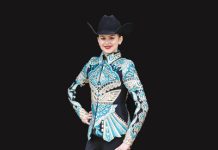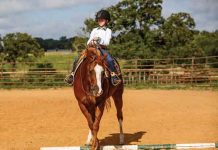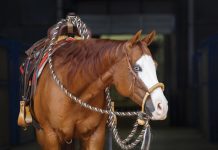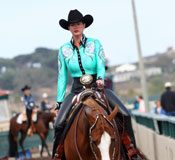 Headset Defined
Headset Defined
The ideal headset for the western pleasure show horse can be seen on a horse that carries its neck flat with the rest of its topline.
In contrast, you don’t want a horse that’s behind the vertical, that looks like he’s intimidated to hold his head. You want to see a horse that’s really relaxed and really comfortable with where he’s carrying his heat and neck.”
Conformation First
To succeed in western pleasure showing, it’s best to start with a horse that’s conformationally suitable for this discipline.
“The more conformationally correct the horse is, the better and easier his chances are of athletically being able to do what we’re asking,” says Heckaman. “We like to see a horse with a long pretty neck that comes flat out of the top of the wither; instead of a neck that comes straight up out of the shoulder. It’s more difficult for a horse to relax his neck at the wither and balance himself if the neck comes straight up out of the shoulder.”
A suitable western pleasure horse should also be long across the topline of his neck and short on the bottom line, which makes it easier for the horse to carry his neck at the ideal level,” says western pleasure trainer Kelli McCamy, who has won several AQHA Congress and World Championships, and whose stallion, Impulsions, is a leading AQHA sire.
But McCamy cautions against a really long neck. “I used to think that the longer the neck, the prettier and the more elegant, but those long necks are really hard to train to carry level. They want to carry them too low or too high.”
Training
Heckaman emphasizes that achieving proper head and neck carriage is the end result of step-by-step training. “If a horse uses his body correctly, he’ll put his neck and head in the right spot. It’s a matter of teaching a horse to balance.”
Because the big money events in western pleasure showing are the futurities, many show horses are trained for western pleasure as 2-year-olds. But, conformation permitting, a horse of any age, regardless of previous training, can be trained to show in western pleasure classes. Retraining mature horses already schooled in other disciplines is similar to training green horses; you go back to the beginning and establish a way of moving, balance, trust, and responsiveness.
“It’s not much different,” Heckaman says. If you have an older hunter, for example, you want to collect his trot. You just go back and school him with the give-and-take to round himself up and shorten his stride up a little bit.”
Regardless of whether you are schooling a youngster or retraining a mature horse, training a western pleasure horse to carry its head correctly takes time. It’s a slow process, because horses learn best through repetition, says McCamy.
Proper head carriage has nothing to do with the type of bit used. It is a mistake to think that a good headset can be achieved by using a high-port curb bit that forces a horse to cam its head a certain way. Trainers like McCamy and Heckaman don’t use bits at all when starting western pleasure horses. McCamy begins by suppling the neck and withers first. Using just a halter and lead rope, she works on the ground with the horse, asking it to bend its neck to one side and then the other. This teaches it to bend its neck and withers in a relaxed manner so that these points will be supple and responsive, she says.
The only training aids that McCamy uses are a sidepull and a fork. A sidepull is a lightweight, halter-like headstall with two pieces of rope that go over the nose, and with rings at the side which the reins are attached to; a fork is like half of a running martingale. It attaches to the girth, and comes from between the legs with two rings that the bridle reins go through,” explains McCamy. “This needs to be very loose; nothing that pulls their head down. It’s not really training them at this point to drop their head in a certain position, it’s just telling them where they can’t go.”
McCamy rides with the sidepull and fork for up to three months. “It’s a slow process,” she says. “But this method teaches them to be flexible in their withers and their poll, and eventually, with repetition, you’ll achieve a good headset without using undue restraint.”
Heckaman also uses the sidepull and the same suppling exercises when riding. “I teach them to follow their heads,” says Heckaman, who asks his horses to give their heads by following the pressure on their noses. Once they do this, he rewards them by releasing the pressure.
From there, the horses are introduced to a mild snaffle. “We start to refine them a little, going back to the basics of asking them to give to pressure with the give-and-take, then releasing them when they give it. We begin working on the lateral movement, taking the right rein and asking them to give their head to the right, then the left rein, asking them to give their head to the left.”
Heckaman works on the horse’s body the same way. We teach them to move away from leg pressure much like we do with their head,” explains Heckaman. “If we put our leg on them and ask them to move forward, once they move forward, we take our leg off. As they start refining, we teach them to move the shoulders around their hindquarters, then their hindquarters around their shoulders, again with a give-and-take from our leg, until we have them responding to leg pressure.”
Fixing Faults
Sometimes, despite good training, headset faults still occur. The key is to recognize the specific fault and then work to correct it accordingly.
Being behind the bit.
This occurs when the horse is not relaxing its head and neck, which puts the horse “behind” the desired horizontal-vertical relationship between the head and neck, and gives the appearance that it is over-arching its neck and tucking its nose in.
“If a horse is not relaxing his head and neck, if he’s tending to strain it a little more than we want, then we encourage him to reach forward more with his head and not come back,” says Heckaman. “If the (mature) horse wants to stay behind the vertical, I’ll go to a milder bit, then lunge-trot the horse, take him out to the pasture, extend the lope, get him up and moving a little bit, get some forward motion in there, and try not to back the horse off. A horse won’t go behind where his legs are going, so if I can get his legs extended, his nose will follow his legs.”
Too far ahead of the vertical.
Heckaman suggests using equipment that will create a little more sensitivity, such as a lighter snaffle. “And do some exercises to supple the neck and poll,” he says. “Soften the mouth and make him give his head a little more, so when you release the rein, he goes into a more balanced position.”
Heckaman advises working on exercises that ask the horse to bend its head. “Take his neck and head from side to side, encouraging him to go forward with the legs, but asking to give his head,” says Heckaman. “Make sure one rein is independent from the other rein, and then alternate reins, asking him to give his head to the right and move forward, then asking him to give his head to the left and move forward.”
If conformation causes the head carriage to be ahead of the vertical, then the rider needs to continually work at helping the horse to stay at the desired vertical.
“You can make a horse put his head in the correct place,” says McCamy, but it’s a constant problem and you’ll have to work on it every single day.” Like Heckaman, McCamy develops flexibility by pulling lightly on alternate reins as the horse is moving forward. “They will eventually drop their neck, and when they do, release them,” says McCamy, who prefers doing this exercise in a snaffle and fork.
Too low to the ground (peanut roller).
McCamy and Heckaman recommend picking the horse’s head up to the desired level, or even over-elevating the head a bit, and to teach the horse through repetition to ease away from the pressure by raising its head.
Riding with an over-check can also help a horse that carries its head too low. Notes McCamy, without you having to constantly pull all the time, this teaches them that the more they raise their head up, the less pressure they have; the more they lower their head, the more pressure they have.” To make an over-check, take a small rope, and either (1) tie it from the top of the bridle from the poll back to the saddle horn or (2) attach it to each side of the bit, then run it across the nose, up the forehead, underneath the bridle, and back to the saddle horn. McCamy warns against tying the over-check too tightly to the saddle horn. It should not prevent the horse from comfortably lowering its head to a desired position. Lunge the horse five to ten minutes first, to ensure that it won’t resist the device.
Staying in frame.
Keeping the horse working within its frame is most important, because it is both the trainer’s goal and it is what the judges are looking for. Only a balanced horse can do this.
“A lot of riders get a horse out of its true frame by trying to fix the horse’s head,” says McCamy. “They constantly pull with their hands so much that they lose the legs, slowing the horse’s movement so the horse can’t go forward. This is where your legs come in. You’ve got to keep the horse going forward to keep the horse in his true frame.”
To avoid “falling out of frame,” correct head carriage should be taught in conjunction with teaching proper balance and movement. “If you’ve got a trained horse that you’ve worked on by repetition,” explains McCamy, “you’ve got a horse that carries his head properly.”
McCamy says that when getting ready for a show, she doesn’t worry about headset. If it’s already there, then it’s just a matter of keeping the horse moving, keeping him in his frame, keeping him collected and keeping him moving properly, she says.
“On the other hand, if you have a horse that’s not been to many shows, and he wants to look around a little bit, then the night before show (I’ll) ride him with the fork,” says McCamy. “This helps keep his attention, keeps him focused, and reminds him where that head is supposed to be.”
No Short Cuts
When developing the western pleasure horse, certain training aids, such as the fork, sidepulls, and an occasional over-check, used in conjunction with sound training techniques, can help the horse understand your expectations.
According to McCamy, training aids can give you a mechanical advantage when teaching a horse, with less trauma. “You can certainly train a horse to carry his head properly without training aids, but you may end up doing a lot more jerking and pulling and putting the horse under a lot more pressure.”
But training aids are not intended to be used as shortcuts or time-savers. When used with a program of repetition, training aids teach a horse to move away from pressure, rather than pulling against it.
“That’s what we’re teaching with the sidepull and the fork,” says McCamy. “Repeated procedures are less traumatic than jerking and pulling all the time.”
Any training aid that’s misused or overused can be abusive and damaging. “I’ve seen people lunging their horses with the bridle reins tightly tied between the legs,” says McCamy. “The neck is all bowed up and the head is behind the vertical. When a horse is pulled in this much and overdone, he can’t go forward, so it hampers his natural gait. Too many training devices hamper movement.”
Draw reins and martingales have their place in certain instances, for very short periods of time, but when novices rely on them, you can damage a horse, says Heckaman. “People tend to ride a horse in draw reins, and pull the head down and into a frame and hold it there. Then the horse gets dull on the snaffle and gets down on their forehand.”
According to Heckaman, using restrictive training aids creates pull points that are different than when the contact is direct. “If you ride in a martingale, with the reins running through the martingale and to the bit, whenever you pick up the reins, the martingale pulls more down between the horse’s front legs,” he says. “Then, when you take the martingale off, you’ve got more of a straight-line pull from your hand to the horse’s mouth, so it feels different. So you end up going back to school the horse to respond to straight-line contact, anyway.”
There are no shortcuts to finishing the western pleasure horse and getting nice head carriage. “It takes a lot of time,” McCamy says. “A horse is trained by repetition only. When the horse is properly trained, when you take the time to train the horse and the conformation is pretty correct, everything else just falls into place and the headset will be there.”
Further Reading
Soft Hands






This article tells you what to look for when your horse is doing fault but doesn’t give you a step by step direction on how to fix it all the way.
I like the article, it was very interesting on what you had to say about western headset, and how the horse should carry his or her head and neck when in the show ring.
Thank you for this article!!!!!!!!!!!! I really hope that the message of higher head sets gets out to more people. I show with people who force their horse to carry their head at such an extreme leverage, that they’re eating dirt. I will never allow my horse’s head to go that low. My horse is proud to be a horse, and will never hang her head in shame.
This really helped me work with my horse.
Very good article on a difficult subject.
I love the “new” headset for the western pleasure comapred to A few years ago.
I liked the article, but it seemed to me that at the end they really hadn’t answered how to get the headset.
excellant article. Please post more like this!
In my opinion, this article is incorrect.When you show on the circuit and at youth world show and congress,your horse must have a really low headset.
Good article!
This was a very good and informational article!
I have ridden horses most of my life. I learn from probably 20 trainers and the way of training. I take it all and do what I feel works for me and my horses. It was great to know, with me going out on my own training, that I was right on with the article you had on head sets and training and retraining. I was so excited. The entire time I was reading I was saying to myself I do that. Wow, they do that too.
I just got married and my last name is Fields now. The address is the same. (Melissa Bryson 2319 George York Road, Randleman NC 27317
What about a horse thats has to much go in the lope so close to a run, when she starts tht I bring her into a smaller circle and try to let her know that a smaller circle will be harder for, finilly she will slow down, but then when we go back to the full size arena she begin to speed up so what can I do My email address is n tobiano@peoplepc.com
Wonderful article! I am running into a brick wall and it is testing my patience but we will get through this. If I work on the speed for the lope the head and neck come up and if I give him his face and he relaxes he speeds up. Want to show and play with the bigger boys but it wont happen this year. Keeping my fingers crossed for next year …..
This is great information and I will take it and work with my mare. I will probably refer back to it several times until we get it right.
GREAT way of explaining it! I have tried many things to help get my horse’s head down where it should be. I don’t expect her be perfect but I just want her head near where it should be. After all she is a TB/Perch/QH cross!
What do you mean by the ” give and take “? Training Western Pleasure Headset , collect his trot.
Thanks,